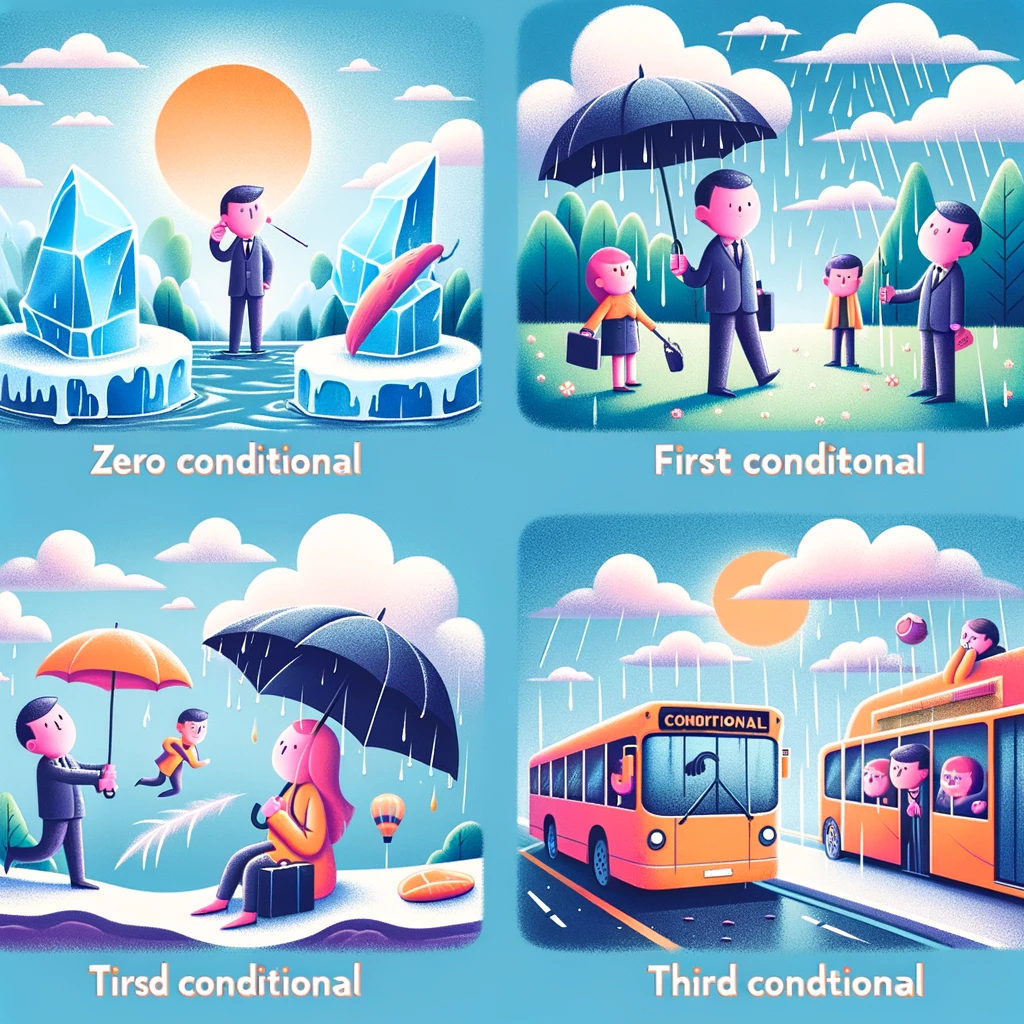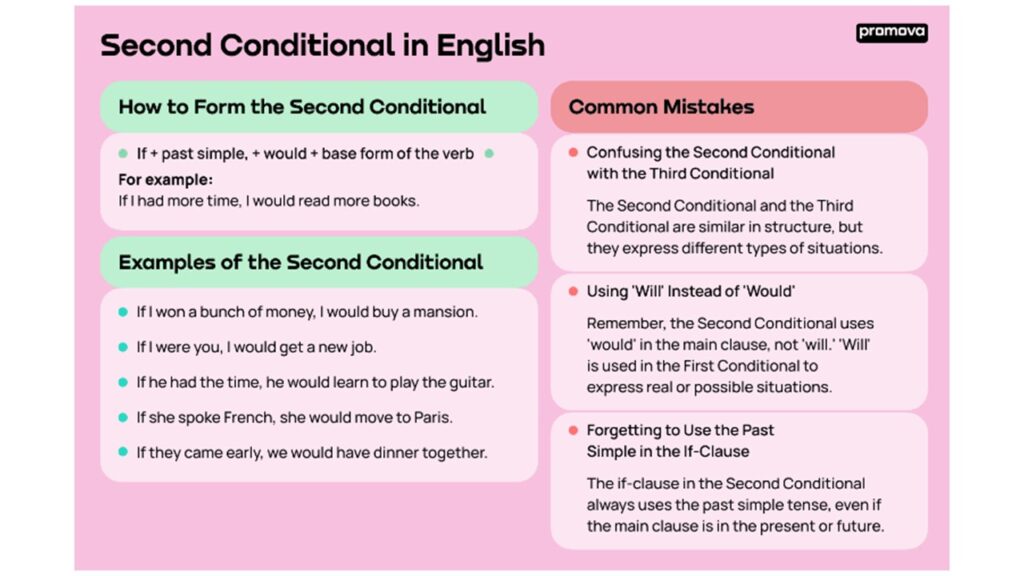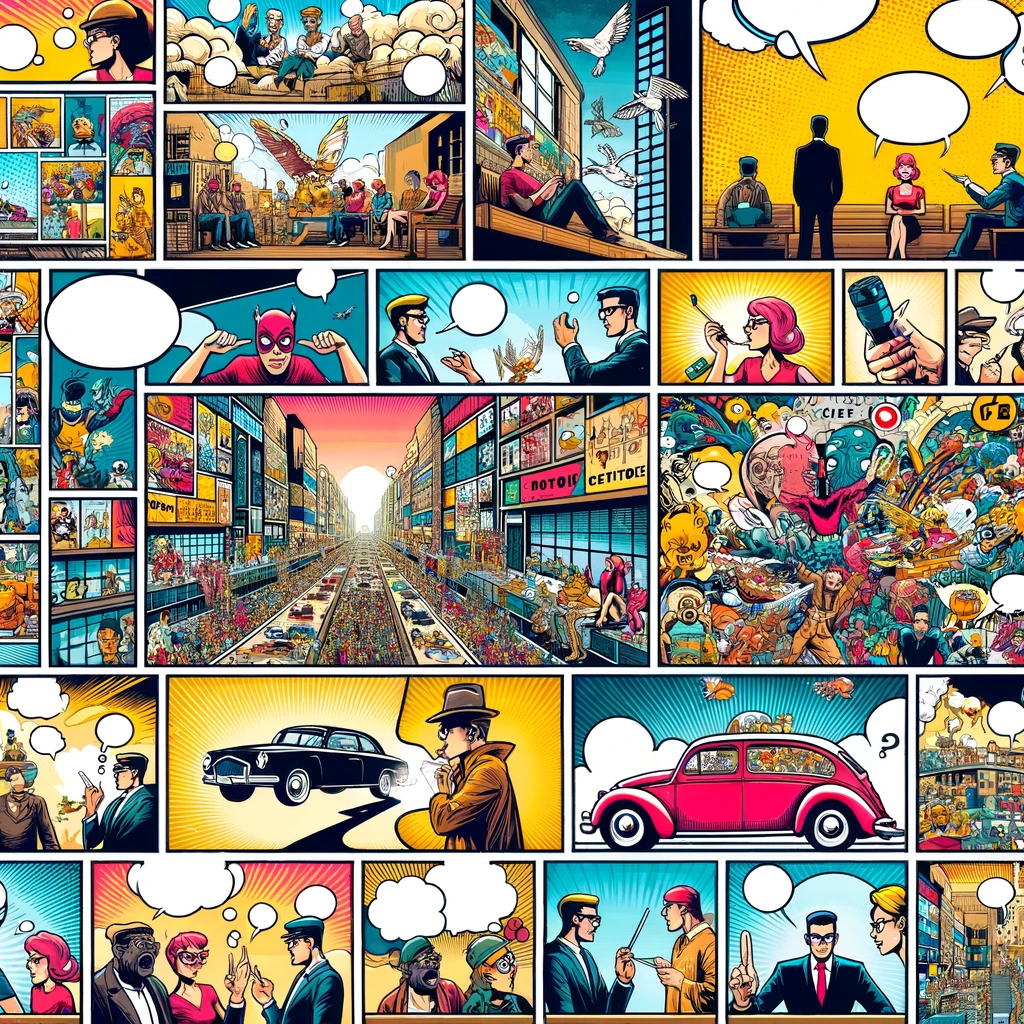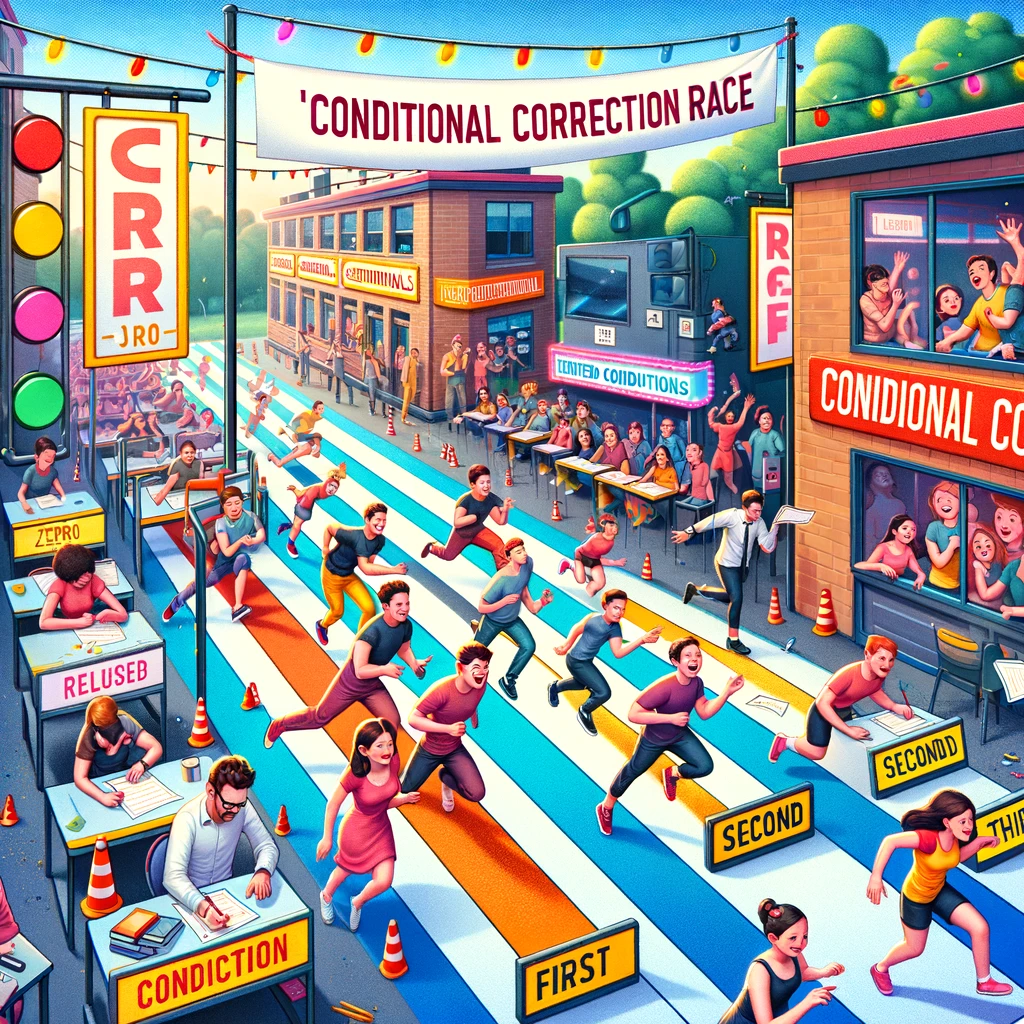SECOND CONDITIONAL

The Hypothetical Situation
- Learning Objectives: Apply the second conditional to discuss unreal or hypothetical situations.
- Form (If + past simple, … would + base verb) for imaginary scenarios.
- Practical Examples:
- “If I won the lottery, I would travel the world.”
- “If I were you, I would apologize.”
Resources

LEARNING ACTIVITIES
“If I Were President” Speeches
Objectives:
- Enhance Public Speaking Skills: Develop your confidence and ability to articulate your thoughts and ideas clearly in a public speaking setting.
- Critical Thinking and Problem-Solving: think critically about societal, environmental, or educational issues and propose creative solutions.
- Understanding Civic Responsibility: Foster a deeper understanding of civic responsibility, governance, and the impact of leadership decisions on society.
- Application of Conditional Structures: Reinforce the use of the second conditional in constructing hypothetical scenarios and proposals.
Instructions:
- Introduction to the Activity (10 minutes):
- You will learn the purpose and structure of the activity. We will highlight the importance of understanding civic issues and the role of leadership in enacting change.
- We will review the second conditional structure (If + past simple, would + base form of the verb) for crafting hypothetical scenarios.
- Topic Selection and Research (20 minutes):
- Select a topic or issue they are passionate about addressing as a hypothetical president. Topics might include education reform, environmental protection, healthcare, or social equality.
- You’ll have time to conduct a brief research on your chosen topic to understand the current challenges and potential solutions.
- Speech Writing (30 minutes):
- Draft your speeches, starting with an introduction that outlines the issue they plan to address. The main body of the speech should detail the changes you would implement if you were president, using the second conditional to describe your hypothetical actions and the expected outcomes.
- Conclude your speeches with a powerful statement on the importance of the issue and the positive impact your changes would have on society.
- Peer Review (15 minutes):
- In pairs or small groups, you will exchange your speech drafts for peer feedback. Peers should focus on the clarity of the message, the effectiveness of the proposed solutions, and the correct use of the second conditional.
- Give constructive criticism and suggestions for improvement.
- Speech Presentations (45 minutes):
- We will set up a “Presidential Podium” at the front of the class where you will deliver your speeches.
- Each student takes turns presenting their speech to the class. Listen actively and prepare to ask questions or offer comments after each presentation.
- Class Discussion and Reflection (20 minutes):
- After all speeches have been presented, we will have a class discussion on the experience. We will discuss the variety of issues addressed, the feasibility of the proposed solutions, and the importance of leadership in making a difference.
- Reflect on the use of the second conditional in expressing hypothetical plans and its effectiveness in persuasive speech.

Dream Day – Writing with the Second Conditional
Objectives:
- Enhance Grammar Skills: Strengthen your’ understanding and application of the second conditional in describing hypothetical situations.
- Foster Creativity: Use your imagination to envision and describe your ideal day in detail.
- Improve Writing Coherence: Develop your ability to organize your thoughts and write coherent paragraphs using conditional sentences.
- Promote Self-reflection: Provide an opportunity for you to reflect on your desires and aspirations, promoting self-awareness and goal-setting.
Instructions:
- Introduction to the Second Conditional (10 minutes):
- We will begin with a brief review of the second conditional structure: If + past simple, would + base form of the verb. It’s used for hypothetical situations or dreams that are not likely to happen in the present or future.
- We will see some examples related to the theme of a “Dream Day” to model the structure and usage. For example, “If I had a million dollars, I would travel around the world.”
- Brainstorming Session (15 minutes):
- Spend a few minutes brainstorming ideas for their perfect day. Think broadly about locations, activities, people you would be with, and any special events that would make the day ideal.
- You will be provided guiding questions to spark ideas, such as “Where would you go if you could visit any place in the world?” or “What activity have you always wanted to try if you had the chance?”
- Writing the Paragraph (20 minutes):
- Write a descriptive paragraph about your dream day, using the second conditional to outline the events of the day and explain why it would be perfect for you.
- Use of vivid details and sensory language to bring your dream day to life for the reader.
- Peer Review (10 minutes):
- Exchange your paragraphs with a partner for peer review. Provide feedback on the use of the second conditional, as well as the clarity and creativity of the description.
- Give constructive criticism and suggestions for improvement.
- Class Sharing and Discussion (15 minutes):
- Share your dream day paragraphs with the class. After each reading, allow for brief feedback and discussion.
- Highlight effective uses of the second conditional and creative ideas that stand out.
- Reflection (5 minutes):
- We will conclude the activity with a reflection on the process of using the second conditional to describe hypothetical desires. We will discuss how imagining such scenarios can be a useful tool for setting personal goals and recognizing individual aspirations.

Conditional Comic Strips
Objectives:
- Reinforce Grammar Knowledge: Solidify your understanding of zero, first, and second conditionals by applying them in creative comic strip narratives.
- Creative Expression: creatively express ideas and scenarios using comic strips, combining artistic skills with grammatical accuracy.
- Critical Thinking: Develop your ability to think critically about how different conditional forms can alter the outcome of a story or situation.
- Collaborative Learning: Foster teamwork and collaboration as you may work in pairs or small groups to brainstorm and develop their comic strips.
Instructions:
- Introduction (10 minutes):
- We will briefly review the zero, first, and second conditionals, highlighting their forms and uses.
- I will Introduce the concept of the activity, I will explain how you will create comic strips that demonstrate the use of these conditionals.
- Brainstorming Session (15 minutes):
- Brainstorm ideas for your comic strips. Think of scenarios where the outcome can change based on different conditions – this can involve everyday situations, imaginative tales, or even science fiction themes.
- If working in groups, you will discuss and agree on one idea to develop into your comic strip.
- Planning the Comic Strip (20 minutes):
- Outline your comic strip storyline, deciding where and how to incorporate each of the three conditional forms. You should plan the sequence of panels and draft the dialogue or captions.
- You will be provided with a template or guidelines for creating your comic strips, including the number of panels and recommended layout.
- Creating the Comic Strip (40 minutes):
- Using art supplies or digital tools, create your comic strips. Each panel should clearly illustrate the scenario and use the conditional sentences correctly to advance the story.
- Be creative in the artwork and storytelling, focus on accurately demonstrating the conditional forms.
- Presentation and Gallery Walk (30 minutes):
- Present your comic strips to the class, explaining the scenarios and how you used the conditionals. Alternatively, we will organize a gallery walk where comic strips are displayed around the room, and you circulate to view each other’s work.
- Give constructive feedback, focusing on the creative use of conditionals and the clarity of the narrative.
- Reflection and Discussion (15 minutes):
- We will conclude with a class discussion on the activity. Reflect on the challenges and successes of incorporating grammatical structures into creative work.
- We will discuss the importance of conditional forms in everyday communication and storytelling.

Mixed Conditional Practice Activities
Here are several engaging activities designed to help you practice and master mixed conditionals, a more complex aspect of English grammar that combines different time references in the condition and result parts of sentences.
Conditional Correction Race
Objectives:
- Reinforce Grammar Skills: Enhance your understanding and correct usage of zero, first, and second conditionals by identifying and correcting errors.
- Promote Quick Thinking: Develop your ability to quickly recognize and correct grammatical mistakes under time constraints.
- Foster Competitive Learning: Utilize a fun, competitive format to engage you actively in grammar practice.
Instructions:
- Preparation
- Setup:
- The class will be divided into small teams or pairs to foster a competitive environment.
- The rule will be explained: A sentence will be shown to all teams at the same time. Each team must quickly discuss and write down the corrected version of the sentence.
- Race:
- One sentence will be displayed at a time to the entire class. You’ll have a short time frame (e.g., 30 seconds) to write your corrections.
- After time is up, teams reveal their answers simultaneously. The first team to show a correct and complete sentence earns a point.
- Review:
- We will discuss each correction as a class to ensure understanding and clarify any common mistakes. This review helps solidify the learning objectives and corrects common misconceptions.
- Scoring:
- The team with the most points at the end of the session wins “Krugs.”

Conditional Puzzles
Objective: Develop logical thinking and grammatical accuracy by solving and creating puzzles that use mixed conditionals.
Instructions:
- Puzzle Creation: Each of you or group creates a short story or situation puzzle using mixed conditionals, leaving out key information. (20 minutes)
- Solving Session: Swap puzzles between groups or pairs, challenging you to solve each other’s puzzles. (15 minutes)
- Review: Discuss as a class, focusing on how mixed conditionals were used to create intriguing scenarios and the logic behind the solutions. ( 5 minutes)

What If? Journals
Objective: Encourage reflective and creative writing using mixed conditionals to imagine alternate realities or outcomes.
Instructions:
- Journal Setup: You will have to keep a “What If?” journal.
- Weekly or Daily Entries: You will have to write weekly or daily entries exploring different ‘what if’ scenarios, using mixed conditionals.
- Sharing Session: Regularly, you will have to share interesting entries with the class, and discuss the possible alternate realities you’ve imagined.

Here is presentation with a summary of Zero, First and Second Conditionals:
